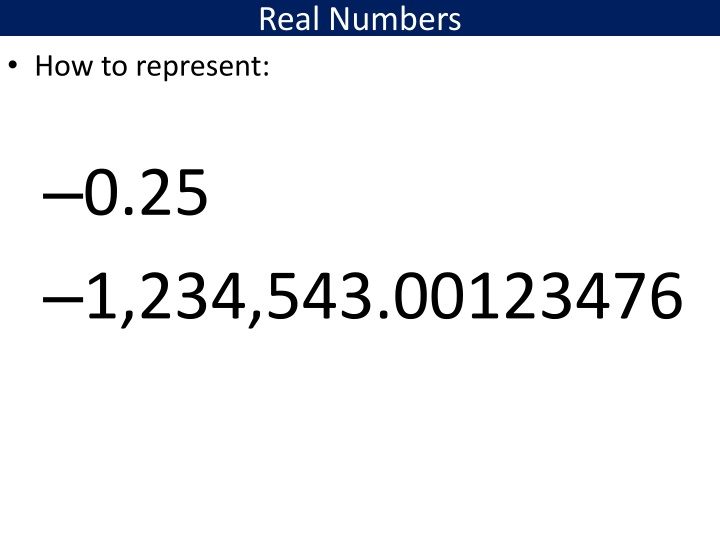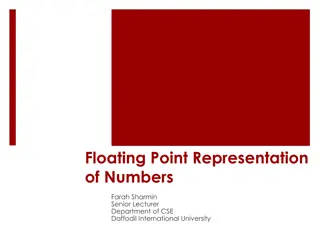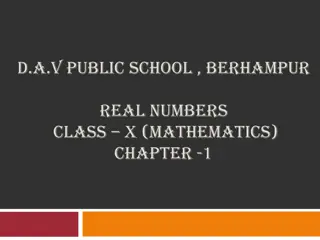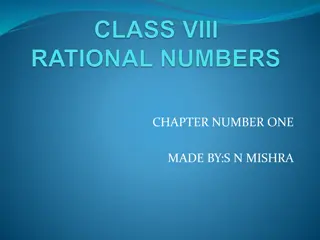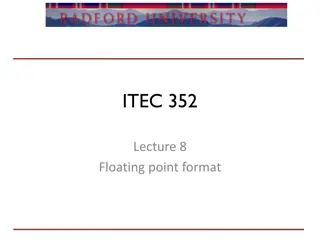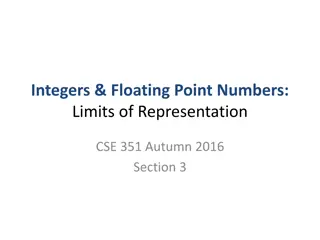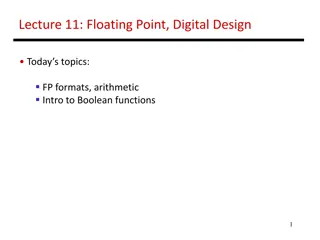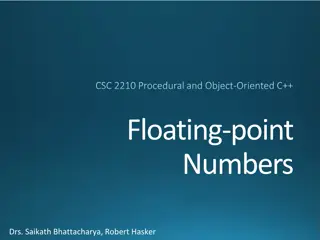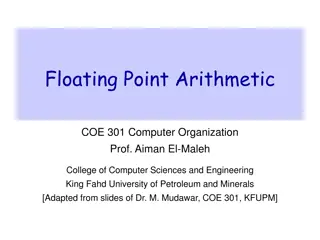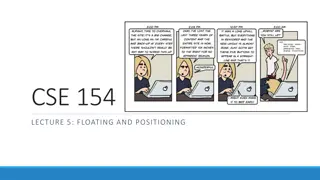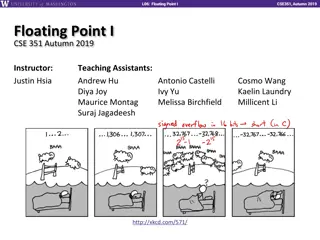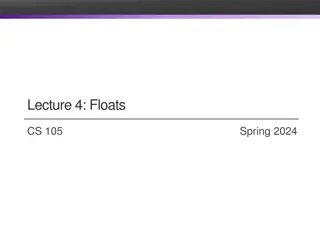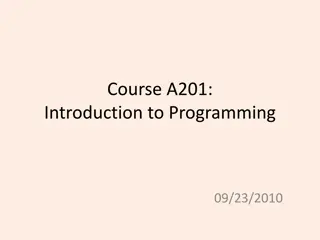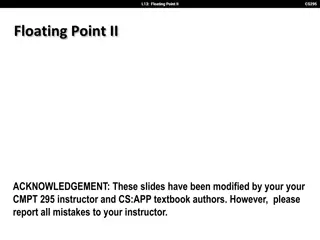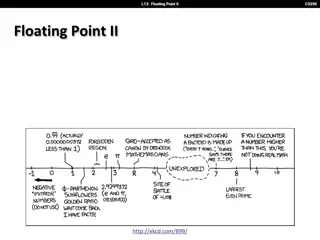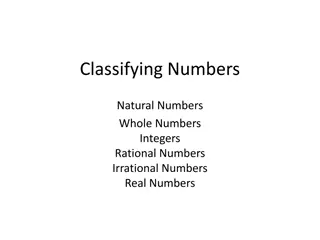Understanding Real Numbers and Floating Point Concepts
Explore the representation of real numbers in various forms like fixed-point and floating-point, as well as the concept of IEEE 754 standard for floating point. Learn about the limitations and advantages of different number representations, such as fixed-point's convention of fixing digits and the flexibility of floating-point to represent numbers with precision. Delve into single-precision and double-precision floating-point formats, understanding the bit structures and their implications.
Download Presentation

Please find below an Image/Link to download the presentation.
The content on the website is provided AS IS for your information and personal use only. It may not be sold, licensed, or shared on other websites without obtaining consent from the author.If you encounter any issues during the download, it is possible that the publisher has removed the file from their server.
You are allowed to download the files provided on this website for personal or commercial use, subject to the condition that they are used lawfully. All files are the property of their respective owners.
The content on the website is provided AS IS for your information and personal use only. It may not be sold, licensed, or shared on other websites without obtaining consent from the author.
E N D
Presentation Transcript
Real Numbers How to represent: 0.25 1,234,543.00123476
What do they mean 12.125 x101x100 x10-1x10-2x10-3
Now lets try in binary Say we had 8 bits: 1011.1011 X x23 x22 x21 x20 x2-1 x2-2x2-3x2-4 = 8 + 0 + 2 + 1 + 0.5 + 0 + 0.125 + 0.0625 11.6875
Fixed-Point Representation Given N bits to represent real numbers The is fixed by convention between two digits e.g., 4.2 representation fractional scalar
The problem with fixed-point Range is small Cannot represent very large or very small or mix Programmers have to use scaling factors
Floating Point: Concept Point can float anywhere we want fractional scalar
Floating point concept contd. 1 1 1 1 1 1 127 0 0 0 0 0 1 0.015625 Range still small Cannot represent very large number or very small ones
Floating-Point Concept Final Given N bits represent as close a number as you can E.g., w/ 6 bits 1 1 1 1 1 1 1 0 1 0 1 1 0 1 0 1 0 0 0 0 0 1 1 1 0 0 0 0 0 0 0 1 0 1 0 0 1 0 0 1 1 1 0 0 0 0 0 0
IEEE 754 Standard for Floating Point 16-, 32-, 64-, or 128-bit Float = 32-bit, single precision Double = 64-bit, double precision In general: S E M 0 + 1 - 1.M 2E x implied
Single-Precision, 32-bit 32 23 8 S E M 0 + 1 - (-1)S x 2E-127x1.M 2E-127 1.M = x 1 10000001 10000000000000000000000 S = - E = 129 127 M = .1 -22 x 1.1 = 1100.0 = -6
Single-Precision, 32-bit 32 23 8 S E M 0 + 1 - (-1)S x 2E-127x1.M 2E-127 1.M = x 0 01111110 11000000000000000000000 S = + E = 126 127 M = .11 +2-1 x 1.11 = 0.111 = 0.875
How to represent a number in IEEE FP STEP 1: Find most-significant 1 0 0 0 0 0 0 0 1 0 1 0 0 1 0 0 1 1 1 0 0 0 0 0 0 STEP 2: Mantissa: digits to the right 0 0 0 0 0 0 0 1 0 1 0 0 1 0 0 1 1 1 0 0 0 0 0 0 STEP 3: Exponent, how many bits till the actual dot 0 0 0 0 0 0 0 1 0 1 0 0 1 0 0 1 1 1 0 0 0 0 0 0 13
Example 00011100110101110011.11110011101 00011100110101110011.11110011101 00011100110101110011.11110011101 mantissa 00011100110101110011.11110011101 16 0 1000111 11001101011100111111001 S 143-127 mantissa
Floating Point is not always precise 00011100110101110011.11110011101 Was represented as: 00011100110101110011.1111001 The error for SP FP is within 2-23 In general given a number x FP represents: lost x Error: x x There is a number such that: 1 + = 1 Machine epsilon
Floating Point is not always precise Relative Error x x / x = Number represented is: x = x (1 + ) Error in the units in the last place, ulp Spacing between two successive floating point numbers Within 0.5 ulp with rounding to nearest 1 ulp with truncation
Got to be careful with calculations Say want to calculate: A + B With FP we ll get this: A (1 + A) + B (1 + B) But this may not be possible to represented exactly, so we have: (A (1 + A) + B (1 + B))(1 + 3) Which evaluates to: A B [1 + A / (A + B) ( A+ 3) + B / (A + B) ( B+ 3)] What happens when A ~ B?
Got to be careful with calculations Say want to calculate: A x B With FP we ll get this: A (1 + A) x B (1 + B) But this may not be possible to represented exactly, so we have: (A (1 + A) x B (1 + B))(1 + 3) Which evaluates to: A x B x [1 + A+ B + 3]
FP calculations may introduce errors Some rules: Be wary of subtracting very close numbers Adding numbers that differ greatly in magnitude
Special Representations If E=0, M non-zero, value=(-1)^S x 2^(-126) x 0.M (denormals) Mantissa is not normalized Very small numbers close to 0 If E=0, M zero and S=1, value=-0 If E=0, M zero and S=0, value=0 If E=1...1, M non-zero, value=NaN not a number If E=1...1, M zero and S=1, value=-infinity If E=1...1, M zero and S=0, value=infinity
